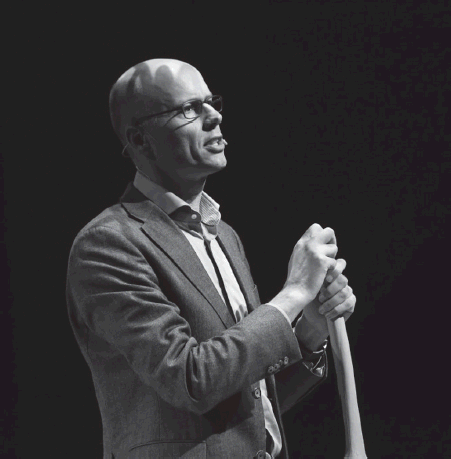“Awkward, I am not longer around and indeed as I forecasted the research and education programs continue at the same pace as before….” Or was there, almost invisible, a vague dimple in the mirrored water of your memory.
May 17 of this year, our dear friend and colleague Professor Edward Valstar, PhD, died at the age of only 47 years. Your battle against just a “bunch of deteriorated pancreatic cells” could not be won, although you were ready to beat them with any technical means, for Carola and your lovely daughters Floor (12) and Merel (8).

Edward Valstar at TedX Delft: Joined at the Hip
Edward started his scientific career at the Department of Orthopaedics at Leiden University Medical Center (LUMC), The Netherlands in 1993, just after finishing his master in Mechanical Engineering at Delft University of Technology. His assignment was to start clinical RSA research, since RSA in Leiden was until then only used in the anatomy lab by Cees Spoor, PhD. His first appointment in Leiden was for three months, which was gradually renewed and renewed. As an engineer in a clinical environment, he was in a challenging position and we admire him for his perseverance in these early days. For Edward, collaboration was important and he succeeded in building many bridges between scientists, engineers and clinicians. Working together with Prof. Hans Reiber, PhD and Henry Vrooman, PhD from the Division of Image Processing at the LUMC, he succeeded in developing the first Digital RSA system that is still the basis of our current Model-based RSA software. With his clinical counterpart, Rob Nelissen, he started clinical RSA studies with the Leiden RSA system. The close collaboration between both the engineer and the clinician stimulated not only the initiation of a multitude of clinical and more technical studies, but also the development of hardware for RSA: a tantalum marker insertion instrument which was easy to handle during surgery, development of the calibration box (which was of glass during the first study), necessary to calibrate the stereoroentgen images. When the first clinical studies with the Leiden RSA software were presented at the EFORT/EORS congress in Barcelona in 1997 some discussions were provoked by the up to that timepoint dominant groups in the RSA field from Sweden, who became close friends in the years to follow. The latter was not only due to the RSA expertise from Leiden, but mainly due to Edward’s gift to bring people together even when they had opposing ideas. Eventually an EU travel grant between Lund (Leif Ryd) and Leiden started, giving an extra boost to model-based RSA. Again, the social aspects of the visits to Lund, having social interactions between Leif, Mike Dunbar, Edward and Rob promoted to a great extent the possibilities on bringing RSA to the next level. One of the papers was a comparison between the Leiden and the Lund RSA systems, but also the RSA standardization paper and the ISO certification of RSA originated during dinner and a beer or two in the evening. In 2001, Edward defended his PhD thesis (with professor Leif Ryd and professor Rik Huiskes as member of the opposition committee) entitled: “Digital Roentgen Stereophotogrammetry: Development, Validation, and Clinical Application.” In Leiden. we still call his thesis “The RSA Bible”.
After finishing his PhD, Edward founded the Biomechanics and Imaging Group (BIG). Eric Garling was his first PhD student as co-supervisor and Bart Kaptein started his work on further development of the RSA software. The focus of his research was broadened by interest in the minimally invasive re-fixation techniques for loosened implants developed in Leiden. One of his quotes: “I accept implant loosening, but I do not accept revision surgery”. This meant again close collaboration between several groups, which was also his drive as founding member of the International Radiostereometry Society and being a board member of the European Orthopaedic Research Society.
Although intrigued by bringing engineering to the clinic, Edward was a family man. He adapted his working hours in order to bring his daughters to school and during holidays, he was not available for work. As a tutor, researcher, and colleague, Edward was always supportive, critical, and perfectionistic. Also to the extent that he could spent quite some time finding the best flight schedules and affordable hotels for the many trips we as research group went on. When Eric booked us a hotel next to the bus station in Oxford, Edward moved after the first night to a college room to have a more quiet sleep. His PhD students remember the many corrections he made in manuscripts that always shortened and improved the text. Some of his PhD students will remember his quote: “Even though writing is still as fast, the new insights will hunt you down.”
In 2012, he received a dual appointment as professor, meaning that he belonged to the select group of Medical Delta professors – professors who have combined expertise in technology and health care and hold a chair both at the University of Leiden as well the Delft University of Technology. In 2015, he spoke out his dream in a TEDx Delft presentation entitled “Joined at the hip” in which he presented his plans to develop maintenance technology such as re-fixation in order to have implants last a lifetime (to be seen at YouTube).
As a teacher, Edward was closely involved with the Clinical Technology bachelor and master program. In March 2016, he became director of this program. Unfortunately, Edward fulfilled this role for far too short time. His students remember him as a compelling man with a passion for his field and an inexhaustible enthusiasm. Edward was an inspiring speaker with a great sense of humor. Indeed, one statement that will never be forgotten by students was: "I am bi, bi-academic." This is what typified him as a professor at the two universities, as clinical technology does, a subject that cuts across two worlds, Edward as the proponent of an eco-thinker opposing the ego-thinker.
